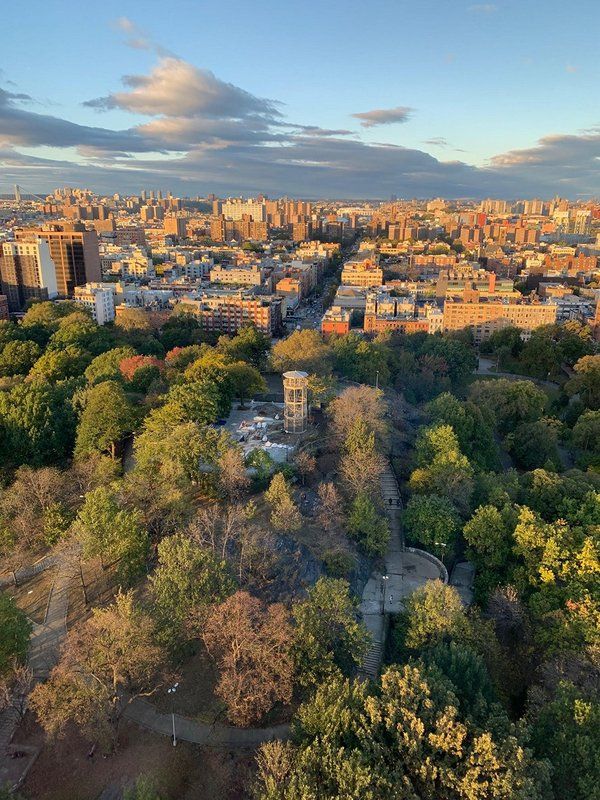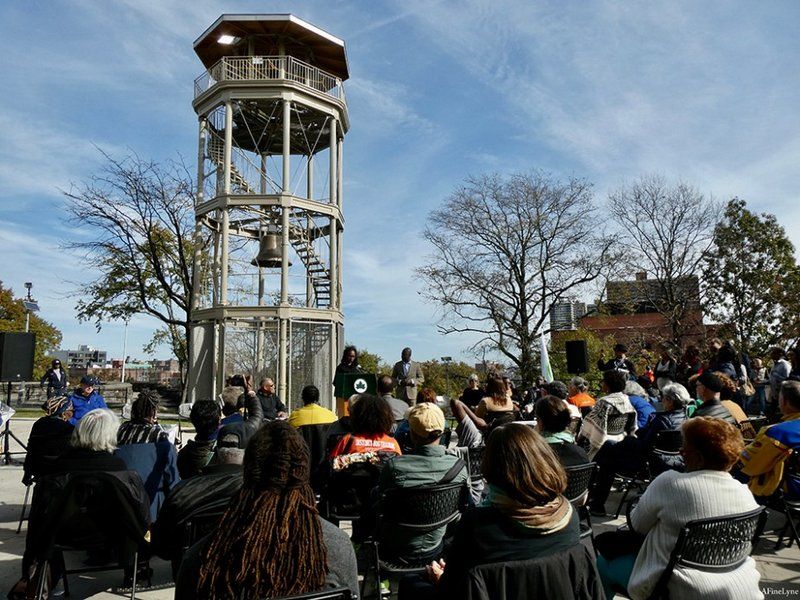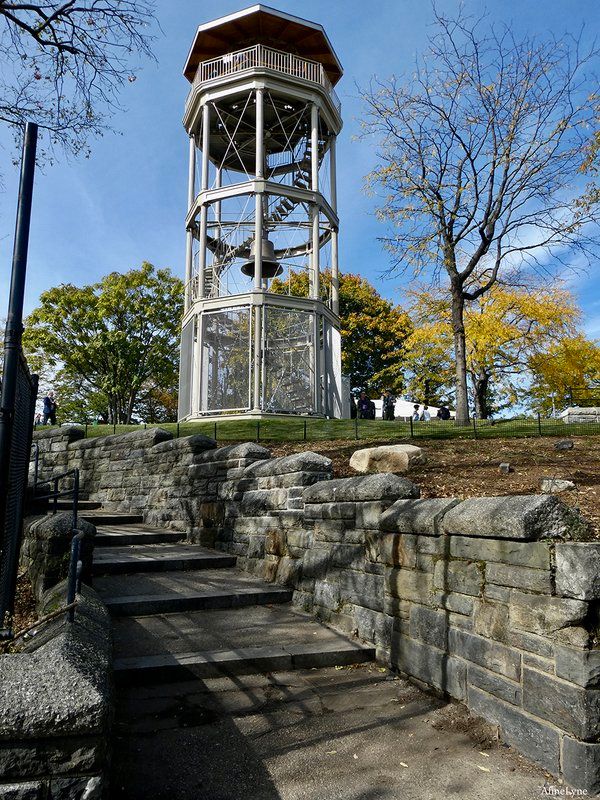Last Chance to Catch NYC's Holiday Notalgia Train
We met the voices of the NYC subway on our nostalgia ride this weekend!


The long-awaited ribbon-cutting for the restoration and unveiling of the historic Harlem Fire Watchtower took place on this past Saturday, October 26, 2019, to the delight of the entire community. The Harlem Fire Watchtower was built by Julius H. Kroehl sometime between 1855 and 1857, and designed by James Bogardus at a cost of $2,300. Fire watchtowers were the way city dwellers spotted fires and sounded an alert, before electric telegraphs were installed in 1878.
The Harlem Fire Watchtower was located at the highest part of the Acropolis (70 feet above ground, known as Snake Hill and built as part of a WAP project) in the center of Marcus Garvey Park (formerly Mount Morris Park), between 120th and 124th Street. The tower alerted all of northern Manhattan of fires — three bells for Yorkville, four bells for Bloomingdale, five bells for Harlem, six bells for Manhattanville, and so on.
The Harlem Fire Watchtower was designated a City Landmark in 1967, and listed on the National Register of Historic Places in 1994. It is constructed of cast iron, composed of three tiers of fluted columns superimposed on each other, and a spiral cast iron stairway leading to the top of the tower. It has a smaller, eight-sided open lantern at the top, which served as an observation booth to protect the volunteer watchmen from bad weather. It stands 47-feet tall, with a bell weighing 5,000 pounds. Age and weather had taken a toll on the beloved watchtower, the last surviving fire watchtower of the original thirteen that dotted Manhattan.
 Photo courtesy of AFineLyne
Photo courtesy of AFineLyne
The tower, exhibiting a great deal of deterioration in recent years, was in great need of restoration. Drawings were prepared and presented to the Landmarks Preservation Commission, the State Office of Historic Preservation and Community Board 11, and a timeline was put in place for the dismantling, renovation and return of the beloved historic structure.
The firm of Thornton Tomasetti was chosen for the restoration, and on April 18, 2014, scaffolding went up around the watchtower, fencing went up around the Acropolis, and the deconstruction began, dismantling the watchtower, piece by piece. Below are images of the final day, when the 5,000 pound bell was removed. The restoration project was extensive, and involved careful inspection and testing of the 176 original components. It was determined that only 39 could be salvaged, and that 137 needed to be recast.

Dismantling of the watchtower in 2015
Five years later, October 26, 2019, the unveiling and ribbon cutting event took place with the Park Rangers opening the gate to allow the public to climb to the top of the newly restored tower — and once again the 5,000 pound bell rung. We have been told that guided tours with the NYC Park Rangers to the top of the tower will take place on several specific dates (TBA) during the year.

The Watchtower ribbon-cutting brought together old time Harlemites who remember playing on the Acropolis as children — they also remember the years when the park and the Acropolis were too dangerous to venture into. Connie Lee, President of the Marcus Garvey Park Alliance, with a ‘thank you’ to all the people and organizations that helped make this day possible, as well as the artists who installed work in the park while the watchtower was down, keeping the park active and welcoming to the surrounding community. They included Lady K Fever with All Along the Watchtower; Suprina’s DNA Totem; and Jessica Feldman, Jerome W. Haferd and K. Brandt Knapp with their large-scale installation, Caesura: a forum on the Acropolis. A special thanks went out to James Terry, who has worked in Marcus Garvey Park for more than twenty-five years.

Ms. Lee also gave a shout-out to local activist, Hilda Stokely, who surely would have been proud of what followed in the wake of her work in the community, as founder of ‘The Friends of Mt. Morris Park‘ (also known as Marcus Garvey Park), which led to the construction of an amphitheater and olympic-sized swimming pool, among other projects. Along with members of the community, local and state politicians were on hand — many of them helped to provide funding. We spotted Manhattan Borough President, Gale Brewer; Assembly Member, Inez Dickens; Council Member, Bill Perkins, Congressman Adriano Espaillat; Nilsa Orama, Chair of Community Board 11; Commissioner of the NYC Department of Parks and Recreation, Mitchell Silver; Chief of Staff, NYC Parks, Steve Simon; and Manhattan Borough Commissioner, William Castro; John Krawchuk, Executive Director Historic House Trust. In addition, local organizations were on site, including Carey King, Director of Uptown Grand Central as she was emerging from her trek to the top of the watchtower. Connie Lee, President of the Marcus Garvey Park Alliance + Director, Public Art Initiative was there along with several board members. Syderia Asberry-Chresfield, Past President of MMPCIA along with other members of the Mount Morris Park Community Improvement Association were there. We also spotted Patricia Pates Eaton, a founding member of MMPCIA and founder of the popular music series in Mt. Morris Ascension Presbyterian Church, Three on 3 Presents.

Marcus Garvey Park has flourished, with an abundance of events and activities including the annual Charlie Parker Jazz Festival, Classical Theatre of Harlem performances, and Jazzmobile held at the Richard Rodgers Amphitheater. The park has an abundance of playgrounds, a baseball field, chess tables, basketball, swimming pool, community center, three little free libraries, free reading to children (on the lawn under the trees), and every Saturday, weather permitting, the Harlem Drummers can be heard at the Drum Circle near Madison Avenue between 123/124th Streets. The park has also been the recipient of outdoor art installations through the efforts of the Marcus Garvey Park Alliance’s Public Art Initiative.
See the process of restoration of the watchtower, from the addition of scaffolding to the dismantling.
A version of this article was originally published on Gotham to Go.
Subscribe to our newsletter